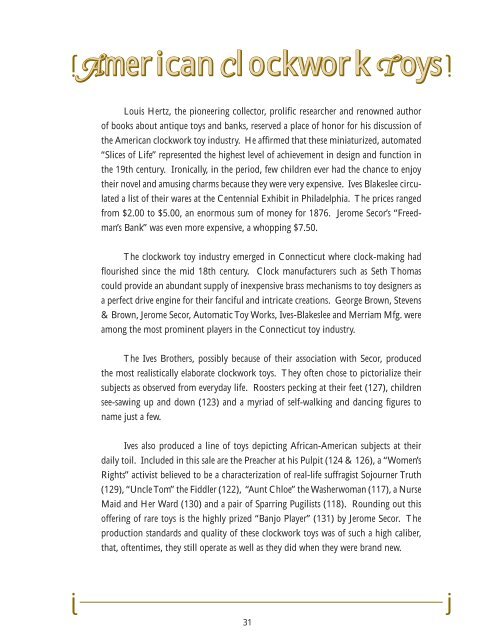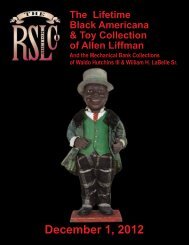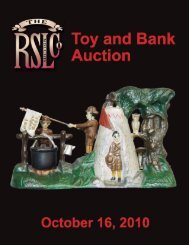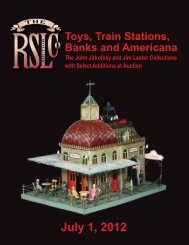The Richard C. Stevens Collection May 22, 2010 - RSL Auction ...
The Richard C. Stevens Collection May 22, 2010 - RSL Auction ...
The Richard C. Stevens Collection May 22, 2010 - RSL Auction ...
You also want an ePaper? Increase the reach of your titles
YUMPU automatically turns print PDFs into web optimized ePapers that Google loves.
j<br />
j<br />
American<br />
merican Clockwork<br />
lockwork Toys<br />
oys<br />
Louis Hertz, the pioneering collector, prolifi c researcher and renowned author<br />
of books about antique toys and banks, reserved a place of honor for his discussion of<br />
the American clockwork toy industry. He affi rmed that these miniaturized, automated<br />
“Slices of Life” represented the highest level of achievement in design and function in<br />
the 19th century. Ironically, in the period, few children ever had the chance to enjoy<br />
their novel and amusing charms because they were very expensive. Ives Blakeslee circulated<br />
a list of their wares at the Centennial Exhibit in Philadelphia. <strong>The</strong> prices ranged<br />
from $2.00 to $5.00, an enormous sum of money for 1876. Jerome Secor’s “Freedman’s<br />
Bank” was even more expensive, a whopping $7.50.<br />
<strong>The</strong> clockwork toy industry emerged in Connecticut where clock-making had<br />
fl ourished since the mid 18th century. Clock manufacturers such as Seth Thomas<br />
could provide an abundant supply of inexpensive brass mechanisms to toy designers as<br />
a perfect drive engine for their fanciful and intricate creations. George Brown, <strong>Stevens</strong><br />
& Brown, Jerome Secor, Automatic Toy Works, Ives-Blakeslee and Merriam Mfg. were<br />
among the most prominent players in the Connecticut toy industry.<br />
<strong>The</strong> Ives Brothers, possibly because of their association with Secor, produced<br />
the most realistically elaborate clockwork toys. <strong>The</strong>y often chose to pictorialize their<br />
subjects as observed from everyday life. Roosters pecking at their feet (127), children<br />
see-sawing up and down (123) and a myriad of self-walking and dancing fi gures to<br />
name just a few.<br />
Ives also produced a line of toys depicting African-American subjects at their<br />
daily toil. Included in this sale are the Preacher at his Pulpit (124 & 126), a “Women’s<br />
Rights” activist believed to be a characterization of real-life suffragist Sojourner Truth<br />
(129), “Uncle Tom” the Fiddler (1<strong>22</strong>), “Aunt Chloe” the Washerwoman (117), a Nurse<br />
Maid and Her Ward (130) and a pair of Sparring Pugilists (118). Rounding out this<br />
offering of rare toys is the highly prized “Banjo Player” (131) by Jerome Secor. <strong>The</strong><br />
production standards and quality of these clockwork toys was of such a high caliber,<br />
that, oftentimes, they still operate as well as they did when they were brand new.<br />
31<br />
j<br />
j





